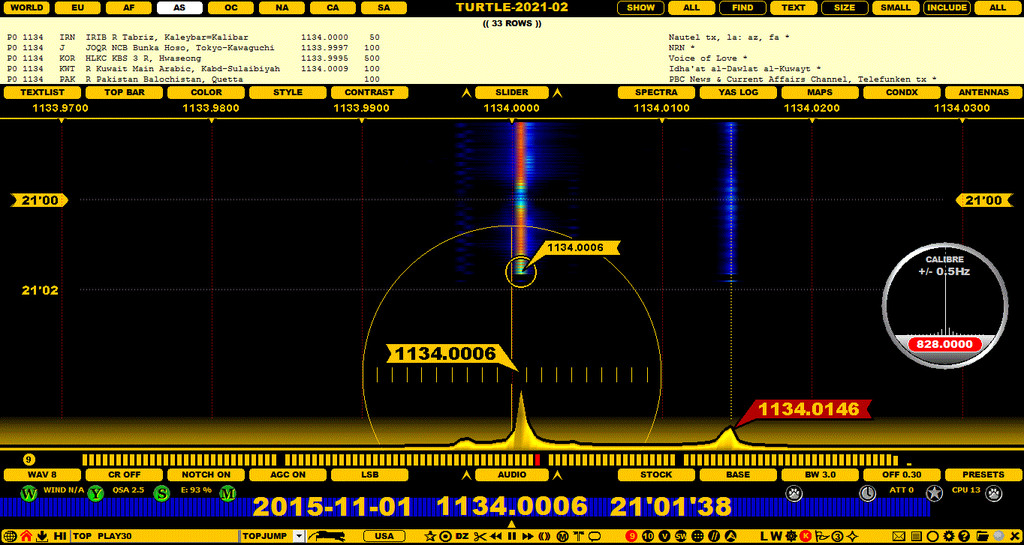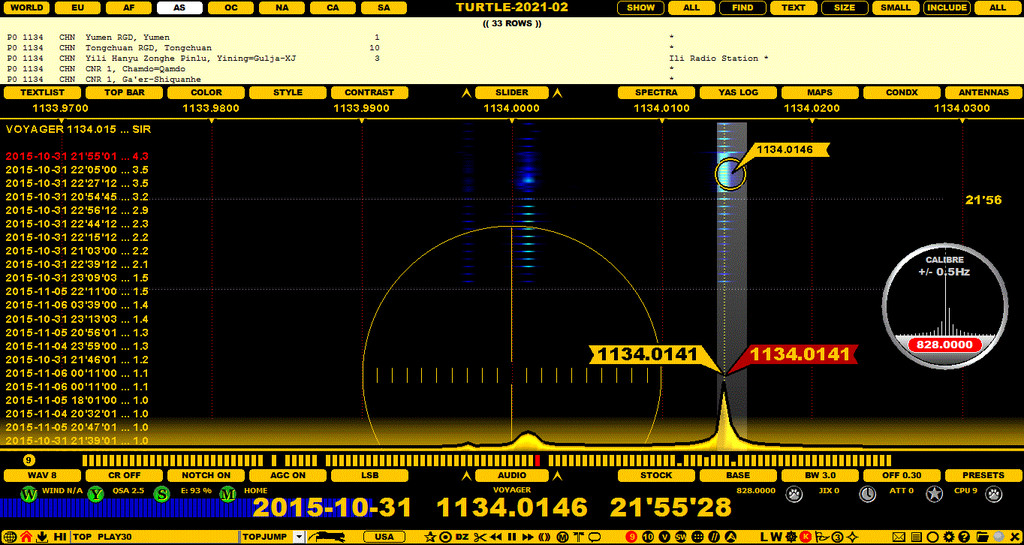
If you happen to have a 5-TB disk (or several of them) full of recordings, you do have a problem, namely, time. How on Earth you will ever have time to dig out all the gold from those files ?
Enter VOYAGER. VOYAGER is a new tool with a lot of potential, available if you have let JAGUAR to create the SCAN files during the recording (or created them afterwards using FILESCAN). Actually, VOYAGER is a "SCAN THE SCAN" tool.
VOYAGER is an explorer which you can send to an unchartered "signal space" (= a hard disk full of recordings) in order to find the time spots where the signal level on a given offset (or within an offset range) potentially reaches the audio level.
It is important to understand that VOYAGER will not search for the time spots where the signal on the desired offset/offset area is the strongest, but where the SIR (Signal-to-Interference Ratio) value is the highest.More info in the SIR help. "Interference" in this context means co-channel carrier peak(s).
SIR must be used instead of the signal power because the absolute signal power on some specific carriers does not necessarily correlate with the audio: even if the signal power is very high at some offset, there can be 20-30 stronger carriers around this nominal frequency. Also, if using only the signal power, we would not get the daytime signals to our result list because the nighttime signal levels are almost always stronger than those of daytime signals. Also, the use of an antenna preamplifier will complicate the analysis: non-amplified signals may not appear in the result list even if they would contain times where audio signals existed.
VOYAGER can give a huge speed benefit for solving UNIDs, either resulting in a fine new DX catch, or revealing that some familiar station has just drifted from its listed offset.
The use of VOYAGER is quite easy: press the "V" key to open the VOYAGER, define the target offset (by default, this is the exact offset you are currently playing, but you can select any other offset by a click of a mouse), define the offset range to be studied, i.e. "the pipe" (move the mouse over the grayed area and use the mouse wheel or left/right arrow keys to increase/decrease the pipe width), then press ENTER. The result list will appear soon (and the control jumps to the time shown at the first entry of the list). If you are lucky, you can identify the station already from this first hit; if not, the VOYAGER result list contains a maximum of 30 potential audio spots.
The idea is probably easiest to describe with an example:

The VOYAGER list shows that the carrier on 1134.015 is 4.3 stronger than the 2nd strongest station on that frequency on 2015-10-31 at 21'55'01 UTC. JAGUAR brings you there automatically when the list has been created and now you hear how Iran dominates at that time on that frequency: the mystery solved.

You can get rid of the VOYAGER list by pressing the "V" key again, returning the control to the time spot where you were when you launched VOYAGER.
A wide VOYAGER pipe is good for offsets that are far away from the nominal. For example, Latin American stations can drift a lot, and they can be trapped with a wide pipe. However, close to the nominal, a wide pipe is not a good idea as it may capture stations that you are not interested in.
The current VOYAGER algorithm ignores the carrier peaks that do not belong to the "TOP 2" (two highest carrier peaks), so when a time spot is picked up to the result set, the pipe contains either the highest carrier peak or the 2nd highest peak at that listed time. If the carrier is the highest at that time, the corresponding SIR value is higher than 1.0. Assuming that the audible station has a carrier which belongs to the "TOP 2" is naturally not always true, but definitely in most of the cases it is. In fact, during an audio peak of a rare weak station it normally rises "to the top", i.e. temporarily it has the highest carrier peak.
The VOYAGER result list can contain real gold (good audio spots) but also "the fool's gold". Even if the SIR value is high, there may be no audio (or even no visible peak at that exact time spot). A good peak does not always necessarily correlate with audio so these spots can be ignored from the studies. If no visible peak exists at the result time, it is either because of calibration issues or corrupted SCAN data. Then, manual FILESCAN for those times may correct the data. However, in many cases, VOYAGER can also really find the spots where a rare station can be identified. In such cases, also the neighboring times should be studied carefully: VOAYGER divides the time space into 10-minute slots, and each picked result contains the best spot within that current 10-minute slot (even if there are many good audio spots within that 10-minute period, it is listed only once). The idea is that we do not fill the result list with times pointing to one "good file" only; instead, the results must be picked evenly from various files on the hard disk.
VOYAGER is still at the experimental stage, and the algorithm will be developed further.